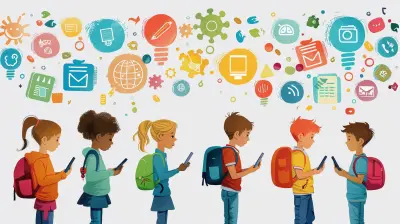The Future of E-Learning: Trends Shaping Online Education
28 April 2025
Technology has transformed almost every aspect of our lives, and education is no exception. The way we learn is evolving rapidly, thanks to advancements in e-learning. What once felt like a futuristic concept is now an integral part of modern education. But where is online learning headed next?
The future of e-learning is bright, filled with innovation and endless possibilities. Whether you're a student, educator, or lifelong learner, understanding these emerging trends can help you stay ahead of the curve. So, let's dive into the key trends shaping the future of online education! 
1. Personalized Learning: Tailoring Education to Individual Needs
Gone are the days of a one-size-fits-all approach to learning. With the help of artificial intelligence (AI) and data analytics, online education is becoming more personalized than ever.How Does Personalized Learning Work?
Imagine having a tutor who understands your strengths, weaknesses, and learning style. AI-driven e-learning platforms analyze user data to create customized learning experiences. They adapt in real-time, offering resources and recommendations tailored just for you.Why It Matters:
- Students learn at their own pace, reducing frustration.
- It provides targeted support, helping learners overcome difficulties faster.
- Engagement increases because lessons align with individual interests.
Personalized learning creates a more effective and enjoyable educational experience, making it one of the most exciting trends in online education. 
2. AI and Machine Learning: Revolutionizing Education
AI isn't just for sci-fi movies—it's changing how we learn. From virtual tutors to smart content curation, AI is making e-learning smarter and more efficient.How AI Enhances Learning
- Chatbots & Virtual Tutors – Just like having a 24/7 personal assistant, AI chatbots answer questions, explain concepts, and provide instant feedback.- Automated Grading – No more long waits for test results. AI can grade assignments instantly, giving immediate insights into performance.
- Adaptive Learning Tools – AI-powered courses adjust based on student progress, ensuring no one falls behind.
AI is making education more interactive, engaging, and tailored, pushing the boundaries of what e-learning can achieve. 
3. Immersive Learning with AR & VR
What if you could travel back in time to witness historical events? Or walk through a 3D model of the human heart? Augmented Reality (AR) and Virtual Reality (VR) are making such experiences possible in e-learning.Why AR and VR Are Game-Changers
- Hands-On Learning: Medical students can practice procedures in virtual environments before working with real patients.- Engaging Lessons: Learning feels more like an adventure, making complex subjects easier to understand.
- Real-World Simulations: Industries like aviation and engineering use VR simulations for safe training experiences.
This immersive approach to education enhances understanding and retention, making learning truly come alive. 
4. Gamification: Making Learning Fun and Interactive
Who says learning has to be boring? Gamification is injecting fun into education by incorporating game-like elements such as points, leaderboards, and rewards.How Gamification Boosts Engagement
- Encourages Healthy Competition: Leaderboards push students to challenge themselves.- Instant Gratification: Badges and rewards provide a sense of accomplishment.
- Enhances Motivation: Learning feels like playing a game, making it more exciting.
When students enjoy the process, they’re more likely to stay engaged and absorb information effectively.
5. Microlearning: Bite-Sized Lessons for Busy Lives
In today’s fast-paced world, attention spans are shrinking. That’s where microlearning comes in—delivering knowledge in small, digestible chunks.Why Microlearning Works
- Saves Time: Lessons are short, usually under 10 minutes, perfect for busy schedules.- Improves Retention: Small doses of information are easier to remember.
- Accessible Anytime, Anywhere: Learn on the go with quick lessons on mobile devices.
Microlearning is particularly useful for skill development, corporate training, and professional certifications.
6. Mobile Learning: Education on the Go
We live in a mobile-first world, and education is following suit. With smartphones and tablets, learning is now available anytime, anywhere.How Mobile Learning Benefits Students
- Flexibility: Study at your convenience, whether at home, on a commute, or during a lunch break.- Interactive Elements: Many mobile apps incorporate quizzes, flashcards, and animations for a more engaging experience.
- Bridges the Digital Divide: Provides access to education in remote areas where traditional schools may be limited.
With the increasing accessibility of mobile devices, mobile learning is set to expand even further in the coming years.
7. The Rise of Social Learning Communities
Learning is no longer just an individual task—it’s becoming more social. Online education platforms are adopting community-based learning to foster collaboration.How Social Learning Enhances Education
- Discussion Forums & Peer Interaction: Students can exchange ideas and help each other understand concepts.- Live Webinars & Group Projects: Encourages teamwork and real-time collaboration.
- Networking Opportunities: Learners can connect with industry professionals and mentors.
By blending social interaction with education, online learning feels less isolating and more engaging.
8. Subscription-Based Learning: The Netflix of Education
Remember when you used to buy books or DVDs for learning? Now, subscription-based models are taking over, much like Netflix or Spotify—but for education.Why Subscription-Based Learning is Thriving
- Affordability: Instead of paying for a single course, users get unlimited access for a monthly fee.- Diverse Course Offerings: From programming to photography, you can learn multiple skills in one place.
- Self-Paced Learning: Learn at your own speed without pressure.
This model provides a cost-effective and flexible approach to continuous learning.
9. Blockchain in Education: Secure and Transparent Credentials
Blockchain isn’t just about cryptocurrency—it’s making waves in education too. It’s being used to verify certificates, degrees, and qualifications securely.How Blockchain Benefits Online Education
- Eliminates Fraud: Digital credentials cannot be tampered with or faked.- Quick Verification: Employers can verify qualifications instantly.
- Permanent Records: Your achievements are stored securely, preventing data loss.
Blockchain ensures trust and transparency in the digital education space, making it a vital technological advancement.
10. Lifelong Learning: The Shift to Continuous Education
Education no longer stops after college. With rapid advancements in technology, continuous learning is essential to stay relevant in the job market.Why Lifelong Learning is the Future
- Career Growth: New skills lead to better opportunities and higher salaries.- Adaptability: Staying updated with trends keeps professionals competitive.
- Personal Development: Learning isn’t just about work—it’s about self-improvement.
Online platforms make lifelong learning more accessible, allowing individuals to upgrade their skills anytime, anywhere.
Final Thoughts
The future of e-learning is incredibly promising. With AI-driven personalization, immersive technologies, microlearning, and blockchain security, online education is evolving in exciting ways. These trends are not just making learning more accessible but also more engaging and effective.If you're a student, educator, or someone passionate about lifelong learning, embracing these changes can open up a world of possibilities. The future of learning is digital—are you ready to be part of it?
all images in this post were generated using AI tools
Category:
E LearningAuthor:

Olivia Chapman
Discussion
rate this article
7 comments
Zeke Sawyer
Thank you for this insightful article! It’s inspiring to see how technology continues to evolve in education. I look forward to embracing these trends in my learning journey.
May 20, 2025 at 1:55 PM

Olivia Chapman
Thank you for your kind words! I'm glad you found the article inspiring. Exciting times lie ahead in e-learning!
Helen McCaw
Great insights on the evolving landscape of e-learning! It's exciting to see how technology and innovative approaches are shaping online education. Looking forward to embracing these trends and enhancing the learning experience for all.
May 8, 2025 at 12:33 PM

Olivia Chapman
Thank you! I'm glad you found the insights valuable. Exciting times ahead for e-learning!
Dorothy McGee
Trends? More like a revolution! E-learning is here to slay, not just play!
May 5, 2025 at 8:28 PM

Olivia Chapman
Absolutely! E-learning is transforming education in profound ways, making it more accessible and engaging than ever.
Jillian McMahan
Ah, the future of e-learning! Where pajamas are the new business casual and the biggest test is whether your Wi-Fi can handle a cat video mid-lecture. Buckle up, students! Online education is about to get a whole lot more entertaining!
May 5, 2025 at 3:18 AM

Olivia Chapman
Absolutely! E-learning is redefining comfort and engagement, making education both accessible and fun. Get ready for a blend of learning and entertainment!
Rivenheart Howard
This article effectively highlights key trends in e-learning, such as personalization and AI integration. However, it would be beneficial to explore challenges educators face in adapting to these changes for a more balanced view.
May 4, 2025 at 4:44 AM

Olivia Chapman
Thank you for your insightful comment! I appreciate your suggestion and will consider addressing the challenges educators face in future discussions.
Atlas McMahon
Exciting insights! I'm eager to see how evolving technology will transform online learning experiences for everyone.
May 3, 2025 at 2:28 AM

Olivia Chapman
Thank you! The evolution of technology indeed promises to enhance accessibility and engagement in online learning. Stay tuned for more updates!
Kathleen Sharp
This article provides valuable insights into the evolving landscape of e-learning. By highlighting key trends, it emphasizes the importance of personalization, innovative technologies, and accessibility in shaping the future of online education, ensuring a more engaging and effective learning experience for all.
April 29, 2025 at 7:30 PM

Olivia Chapman
Thank you for your thoughtful comment! I'm glad you found the insights on personalization, technology, and accessibility valuable for the future of e-learning.
MORE POSTS

How E-Learning is Making Education More Inclusive

How to Use Flashcards Effectively for Exam Prep

Fostering Critical Thinking Through Visual Arts

The Art of Negotiation: How to Communicate Your Terms

Using Technology to Enhance Classroom Learning

Peer-to-Peer Learning in the Age of Digital Platforms